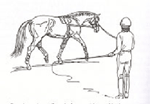HOW DOES VAULTING COMPARE TO OTHER ACTIVITIES?
Safety Comes First

While it can be a thrilling spectator sport, vaulting is not only the safest of the equestrian disciplines, but it is documented safer than riding bicycles, playing on playground equipment, participating in baseball and softball, skating, soccer, and trampolines, among others.
Vaulting injuries are comparable to those seen in gymnastics, and EVUSA injury summary reports demonstrate that the majority of vaulting injuries are sprains. This is due to the three points of vaulting safety that distinguish it from the horseback riding disciplines.
A U.S. Consumer Product Safety Commission report of head injury to children under 15 years of age associated with all types of consumer products demonstrates that total injuries are greatest for 1) bicycles; 2) swings/swing sets; 3) baseball/softball; 4) grocery/shopping carts; 5) monkey bars/playground equipment; 6) bunk beds; 7) carriers/car seats; 8) skating (all); 9) slides; 10) strollers; 11) baby walkers; 12) soccer; 13) playground equipment; 14) trampolines; 15) cribs, all; 16) ATVs; 17) high chairs; 18) hockey; 19) horseback riding. Both the U.S. and German records demonstrate that vaulting has a much lower incidence of injury than the other equestrian disciplines.

HOW DOES VAULTING COMPARE TO OTHER ACTIVITIES?
Safety Comes First
The AVA's observation of "Three Points of Vaulting Safety" is the basis for its superb safety record, and differentiates vaulting from other equestrian sports. These three points are:
• Controlled environment
• Safety training
• Nature of the sport/horse
The "Three Points of Vaulting Safety" directly address what research cites as the major factors contributing to equestrian rider injury:
• Rider loss of control
• Riding environment/suitability of the horse
• Rider knowledge about safety
These are cited as major risk factors with 60 percent of injuries caused by the rider losing control of the horse and 80+ percent of rider injury attributed directly to falls.
In vaulting, all elements—horse, vaulter, longeur, coach, facility, barrel and other equipment—work together to address these risk factors:
Rider Loss of Control
In vaulting the horse is not controlled by the vaulter but by an experienced longeur. Safety is not based on the vaulter's judgment. (Many studies cite young equestrians being "overmounted" as contributing to rider loss of control and injury.) Control of the horse is ground-based on a 20-meter circle in an enclosed arena, with special footing for the comfort and safety of both humans and equines.
The fully equipped vaulting horse may look peculiar to those used to a typical horse with saddle and bridle. Instead of a saddle, a specially designed girth called a vaulting surcingle is used. It has two large leather handles and two leather loops, called Cossack straps, for the feet, rather like stirrups. Beneath the surcingle is a foam pad, for the comfort of the horse.
Riding Environment/Suitability of the Horse
Vaulting is performed in a highly controlled environment—a fully enclosed arena with the horse on the end of a longe line in a 20-meter circle with soft footing. This decreases the likelihood of environmental factors that cause riders to lose control of and possibly fall from their horses. Vaulting's focus is on working harmoniously with the horse. The requirements for the vaulting horse decrease the risk of the horse shying, spooking, running away, etc., all of which can cause rider falls and injury.
Rider Knowledge About Safety
The United States Pony Club Vaulting Handbook states, "Using vaulting techniques, the time required in learning to ride safely can be cut in half. It reduces chances of injury from a fall. Rider training is enhanced with the improvement of confidence, suppleness, balance and rhythm. By increasing confidence and balance, vaulting decreases falls; by teaching proper vault-offs from every position as well as good landings, it reduces chances of injury from a fall."
Attention to safety and safety practices are part of every vaulting practice. Vaulters practice their vault-off and compulsory and freestyle moves on the vaulting barrel prior to working on horseback. The vault-off, in which the vaulter learns to dismount quickly and with control in the event of a loss of balance or emergency, greatly enhances the vaulter's safety

